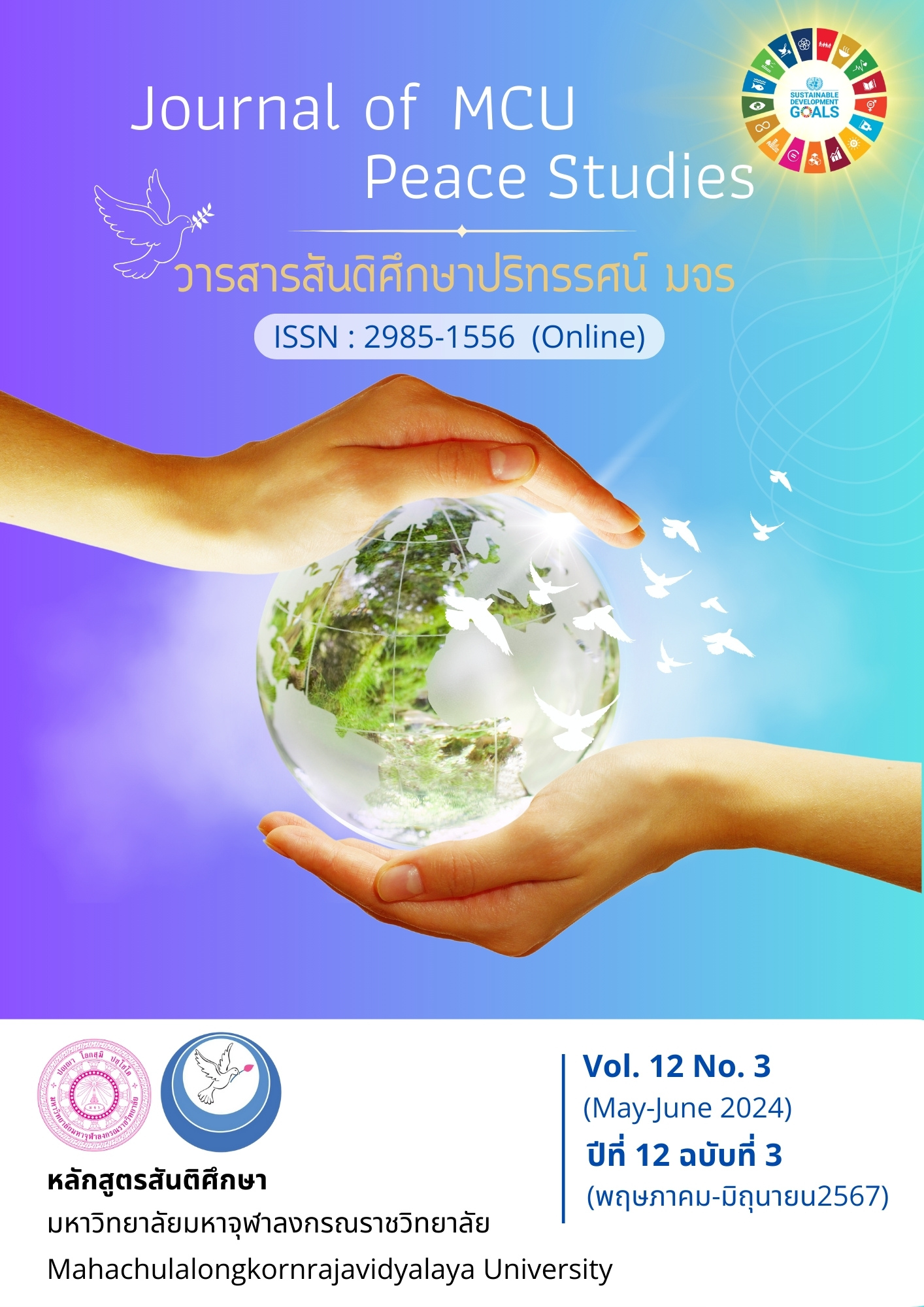การพัฒนาสำนักวิปัสสนากรรมฐาน : “สติริมน้ำ อารามตื่นรู้” เพื่อเสริมสร้างชุมชนเมืองสันติสุขโดยพุทธสันติวิธี
Main Article Content
บทคัดย่อ
บทความวิจัยนี้ มีวัตถุประสงค์เพื่อ 1) ศึกษา บริบท สภาพปัญหา ความต้องการ วิธีการจัดตั้งสำนักวิปัสสนากรรมฐานของมหาเถรสมาคม 2) วิเคราะห์หลักพุทธสันติวิธี และ 3) เสนอกระบวนการพัฒนาสำนักวิปัสสนากรรมฐาน “สติริมน้ำ อารามตื่นรู้” เพื่อเสริมสร้างชุมชนเมืองสันติสุขโดยพุทธสันติวิธี เป็นการวิจัยเชิงปฏิบัติการ ได้แก่ 1. ลงพื้นที่สังเกตการณ์อย่างมีส่วนร่วมและไม่มีส่วนร่วม 2. สร้างการมีส่วนร่วมในชุมชน 3. ลงมือปฏิบัติการพัฒนาสัปปายะในพื้นที่ 4. ประเมินผลจากการพัฒนา โดยมีกลุ่มผู้ให้ข้อมูลสำคัญทั้ง 3 ด้าน จำนวน 13 ท่าน คือ 1) กลุ่มผู้ให้ข้อมูลสำคัญในพื้นที่ 7 ท่าน 2) กลุ่มผู้ให้ข้อมูลสำคัญในหน่วยงานภาครัฐ 3 ท่าน และ 3) กลุ่มผู้เชี่ยวชาญเฉพาะด้าน 3 ท่าน
ผลการศึกษา พบว่า 1) วัดใหม่ (ยายแป้น) สร้างประมาณ พ.ศ. 2390 ในสมัยรัชกาลที่ 3 ตั้งอยู่ที่เขตบางกอกน้อย กรุงเทพมหานคร มีการสอนวิปัสสนาที่ยังไม่เป็นระบบเนื่องจากสภาพแวดล้อมภายในวัดไม่เอื้ออำนวย และการขอจัดตั้งสำนักวิปัสสนากรรมฐานต้องทำตามขั้นตอนของสำนักงานพระพุทธศาสนาแห่งชาติ 2) หลักพุทธสันติวิธีที่เอื้อต่อการพัฒนาสำนักวิปัสสนากรรมฐาน คือหลักสัปปายะ 4 และ 3) กระบวนการพัฒนาสำนักวิปัสสนากรรมฐาน “สติริมน้ำ อารามตื่นรู้” มี 4 ด้าน คือ (1) อาวาสสัปปายะ กิจกรรม Big Cleaning Day ทำความสะอาด ทาสีใหม่ เปลี่ยนบานประตูหน้าต่าง ที่ชำรุด (2) อาหารสัปปายะ จัดหาภาชนะใส่อาหาร โต๊ะวางอาหาร ถวายอาหารที่สะอาด (3) บุคคลสัปปายะ ให้ความรู้ จิตอาสามีส่วนร่วมอำนวยความสะดวกแก่ผู้มาปฏิบัติ รวมถึงดูแลสิ่งของต่างๆ (4) ธรรมะสัปปายะ ผ่าน 4 กิจกรรม คือ สังฆทานสติ สวดมนต์ข้ามปี วันมาฆะบูชา และสามเณรช่อสะอาด โดยมีพระวิปัสสนาจารย์สอนปฏิบัติวิปัสสนาตามแนวทางสติปัฏฐาน 4 เกิดองค์ความรู้ใหม่คือ สติริมน้ำ อารามตื่นรู้ โมเดล
Article Details

อนุญาตภายใต้เงื่อนไข Creative Commons Attribution-NonCommercial-NoDerivatives 4.0 International License.
ทัศนะและความคิดเห็นที่ปรากฏในบทความในวารสาร ถือเป็นความรับผิดชอบของผู้เขียนบทความนั้น และไม่ถือเป็นทัศนะและความรับผิดชอบของกองบรรณาธิการ ยินยอมว่าบทความเป็นลิขสิทธิ์ของวารสาร
เอกสารอ้างอิง
Awararamrasmi, P. (2022). Managing the Temple to Be Happy. Retrieved June 15, 2022, from http://www1.onab.go.th/index.phpoption=com_content&view=article&id=2699:-4-&catid=96:2009-09-19-10-13-59&Itemid=326
Ban Muang Online. (2022). The President of MCU Visited the WAT Next Project, Wat Mai (Yai Pan), Emphasizing Her Full Charisma, Doing Whatever the Masses Support. Retrieved May 30, 2021, from https://www.banmuang.co.th/news/education/291043
Charoen-rajapark, N., & Somjai, S. (2018). Dhamma Practice Model, Management and Dhamma Practice Venue Affecting on Effectiveness in Meditation. Academic Journal Bangkokthonburi University, 7(1), 168-179.
Kaewhawong, T. (2000). Community Strengthening Process Community Civil Society. Khon Kaen: Primary Health Training and Development Center Northeast.
Na Nakorn, T., & Phramaha Sophon Vijittadhammo. (2019). The 4 Foundations of Mindfulness and Human’s Daily Life Development. Buddhist Psychology Journal, 4(1), 116-125.
National Office of Buddhism. (2022). Instruction Manual for Establishing a Dharma Practice Office. Retrieved June 15, 2022, from http://www.esbuy.net/_files_school/00000837/document/00000837_0_20140904-165903.pdf
Phon-armat, T. (2021). The Development Sup-Pa-Ya Place Contributing to the Dharma Practice of the Mindfulness Institute for Peace Prang Ku District, Srisaket Province. Journal of MCU Peace Studies, 9(3), 1028-1039.
Phra Brahmagunabhorn (P.A. Payutto). (2011). Dictionary of Buddhism. (17th ed.). Bangkok: Dhammasapa.
Phra Dhammaworanayok (Opas Niruttimethi). (2003). The Development of the Temple to Be the Center of the Community in the Dharma Review 46. Bangkok: Mahachulalongkornrajavidyalaya Printing Press.
Phra Phuttakhosachan. (2005). Wisuddhimagga Scripture. (6th ed). Taiwan: The Corporate Body of the Buddha Educational Foundation.
Phra Rajapariyatkavi. (2017). Meditation in Buddhism: Lessons from the Maha Satipatthana Sutra and Its Popularity in Thai Society. Mahachula Academic Journal, 4(2), 3-8.
Phra Atit Silatecho. (2021). Efficient Management Model of the Meditation Center. Journal of Education MCU, 8(3), 225-235.
Phrakhruwijitrdhammawiphat (Boonlerd Paññavudho). (2019). Meditation Practice Promotion Development of Meditation Centers in Prachuap Khirikhan Province. Journal of MCU Social Science Review, 8(3), 44-60.
Phrakhuwirojanakhemaguna (Pirot Khemacitto). (2020). The Administration of the Practice Office in Accordance with the Principles of Suitable Things (Sappaya) 4 in Singburi Province. Journal of Social Science and Buddhistic Anthropology, 5(5), 12-25.
Phrakrupaladpannavorawat, & Krongkum, S. (2022). Open the Door to Bangkoknoy Yinyon Watmai (Yai Pan). Bangkok: Limited Partnership Prayoon Santhai Printing.
Phramaha Somsong Sirindhorn. (1982). The Role of Thai Temples and Monks in the Future. Bangkok: Development Religious Committee.
Rodthip, C. (2022). Leader of Wat Mai Yai Pan Community, Bangkok Noi District, Bangkok. Interview. August 8.
Sripaew, W. (2022). Director of Wat Suwannaram School, Bangkok Noi District, Bangkok. Interview. August 8.
Yaot, S. (2019). The Development of the Temple to Be a Sappaya. Journal of Education MCU, 6(2), 200-208.


